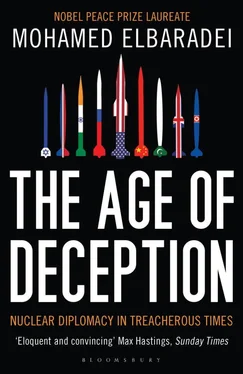We discussed how Iran might pursue dialogue bilaterally with the United States. To some extent, success on a bilateral front would alter the P-5+1 negotiations, making the multilateral efforts easier. But bilateral dialogue needed a pretext to begin. Perhaps “technical discussions” with the United States—advice on how to renovate the research reactor’s control room, for example—could furnish such a pretext?
Salehi was noncommittal. It had been quite difficult, he said, for him to achieve even the progress made thus far.
My next meeting was with Ahmadinejad. I had requested a one-on-one conversation, with only Salehi present to act as an interpreter. I explained to Ahmadinejad the political value of the proposed fuel arrangement and said it would be good for the IAEA to inspect the new facility at Fordow as early as possible, suggesting—as agreed with Salehi—that the inspection take place soon, before October 25. I was mindful of the conclusion of my term but, more important, I wanted to stanch the buildup of speculation by the West. “You should know,” I added, “that Western intelligence agencies were aware of the facility for a number of years.”
Ahmadinejad smiled. “If they really did know,” he replied, “Obama would not have said”—as he had, in a press conference—“that it is possibly a military facility.” Ahmadinejad made no reference to my own statement on CNN that Iran was on the wrong side of the law, in terms of its failure to inform the IAEA about Fordow.
He added that Obama should stop lecturing Iran, stop saying “you must do, you must do” and reproving Tehran in public. Ahmadinejad should understand, I said, that Obama had domestic constraints, to which he replied, “So do I.” Clearly, for Ahmadinejad and for Iran as a whole, respectful treatment by the West was critical. Ahmadinejad was especially dismissive toward Sarkozy, who he said had been “impolite” for some time. He was also insulted that Obama had not responded to his congratulatory message after the U.S. elections. The key to progress in bilateral relations with the United States would be a matter of tone, making Iran feel more like a partner and less like an outcast.
When I mentioned that the application of the Additional Protocol would help Iran’s case, Ahmadinejad said this would not be a problem, but he felt that Tehran needed some sort of positive gesture from the West. Perhaps, I suggested, once the fuel agreement was concluded, the Americans could provide spare parts for Iran’s aging fleet of civilian aircraft. “Spare parts are not so important. We need,” he said, “to get past fifty years of animosity.”
This led me, indirectly, to the sensitive topic of Ahmadinejad’s statements about Israel and the Holocaust. [19] I had discussed this with Salehi ahead of time. He said that if I wanted to approach the topic, I should only do so in a convoluted way. Apparently, in Farsi it is customary to make any critical remarks in a roundabout manner.
“You should not give your detractors an opportunity to misuse your statements,” I said. He understood what I was referring to immediately; nobody in the Arab and Muslim world, he said, was ready to accept the “Zionist regime.”
After the meeting, Salehi passed on that Ahmadinejad appreciated my efforts to help resolve the Iranian issue and had told him, on his next trip to Vienna, to bring a nice present for my wife. Thus Aida received a traditional Iranian vase and a lovely framed verse from the Koran. On leaving Tehran, I myself was given some first-class pistachios. Such are the perks of international civil service.
Although the stage was set for progress, the situation remained delicate. One misstep in any direction could upset the precarious structure we had built.
Two weeks before the fuel proposal meeting was scheduled to take place, on October 21, Hillary Clinton weighed in with a provocative statement. In a press conference with David Miliband, she expressed impatience with the Iranians: “The international community will not wait indefinitely for evidence that Iran is prepared to live up to its international obligations,” she declared. What came next was worse: “With Iran, it is tragic that a country with such a great history, with so much to give to the rest of the world, is so afraid of their own people. The way that they are utilizing secret prisons and detentions, show trials, is a reflection of the discontent that they know people feel toward the current leadership.” [20] Jeff Mason, “Clinton Warns Iran of Need for Nuclear Progress,” Reuters, October 11, 2009.
Ahmadinejad and his colleagues were irate. The Iranian ambassador came to inform us that Salehi would now not come to the fuel proposal meeting. I called Glyn Davies. Clinton’s statement, I told him, had been completely unnecessary and was undermining our efforts to create an environment conducive to negotiations. If such provocations continued, I would give up. I asked him to call Washington to see whether Clinton, who was in Moscow to meet with Foreign Minister Sergey Lavrov, could at least make a separate, more positive statement.
The response was prompt. At a press conference with Lavrov on October 13, Clinton toned down her stance, saying that the United States had a “dual-track approach” toward Iran: “We believe it is important to pursue the diplomatic track and to do everything we can to make it successful. We believe that Iran is entitled to peaceful nuclear energy, but that it is not entitled to nuclear weapons.” [21] “Remarks with Russian Foreign Minister Sergey Lavrov,” October 13, 2009. Transcript retrieved at www.state.gov/secretary/rm/2009a/10/130505.htm .
Lavrov helpfully added that Russia was convinced “that threats, sanctions, and threats of pressure in the present situation are counter-productive.” [22] “Don’t Pressure Iran, Says Russia,” BBC News Online, October 13, 2009.
I called Salehi and Ambassador Soltanieh. I told them I had informed the Americans of Tehran’s angry reaction and pointed to Clinton’s more positive tone. I asked them to convey a message to Ahmadinejad, urging him to take the moral high ground rather than rebutting the United States through the media. Most important, Iran should not squander the opportunity presented by the fuel proposal meeting. The Americans had agreed to discuss the issues Salehi had raised in Tehran: refurbishing the reactor, training Iranian scientists, and the possible sale of a new research reactor. This would be the gateway to a broader dialogue.
Salehi said he could not approach Ahmadinejad again about attending the meeting because the Iranian president was quite upset by Clinton’s remarks. Still, Soltanieh promised he would pass on my message.
“This may be my last chance to help you get engaged with the United States,” I said. I threatened not to hold the meeting if Salehi or someone of his level did not come.
I was not, in the end, required to carry through with my threat. The critical fuel proposal meeting convened in Vienna on October 19, as planned, with Soltanieh present. Dan Poneman—U.S. deputy secretary of energy and a friend of long standing who had worked for many years with Brent Scowcroft and at the National Security Council during the Clinton administration—headed the U.S. delegation. Poneman was a breath of fresh air: bright, modest, a big-picture thinker, always eager to find solutions. The Russian head of delegation, Nikolay Spassky, [23] Deputy head of the Russian Federal Atomic Energy Agency.
was also a first-class diplomat.
The French, on the other hand, came across as hard-line and legalistic. Headed by Frédéric Mondoloni, representative to the IAEA, the French delegation arrived with scores of proposed amendments to our prepared draft agreement.
Читать дальше












